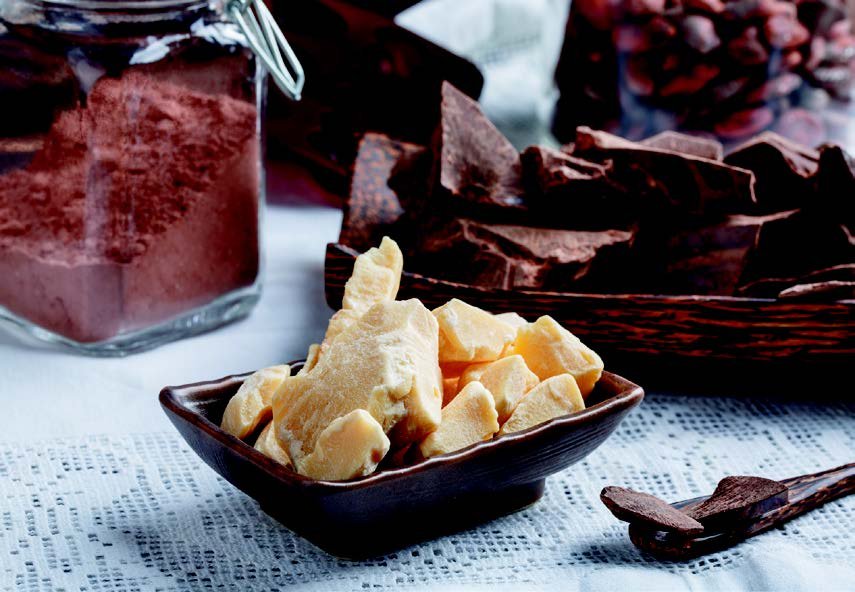
Image © Jupiterimages | Getty Images
Valentine’s Day is just around the corner, and many of us will say, “I love you!” with the classic gift of chocolate. Ever since scientists discovered that cocoa beans contain potentially health-promoting biologically active compounds, chocolate treats have taken on a healthy halo. February seems like the perfect time to examine the current state of science around this crave-worthy confection.
Powerful Phytochemicals. Cocoa beans contain dozens of different phytochemicals—plant compounds that have biological, often health-promoting, effects in humans. Among these are an array of flavonoids. “Some reports suggest flavonoids (like the flavanols abundant in chocolate) have potential antioxidant and anti-inflammatory properties and may improve blood flow,” says Alice H. Lichtenstein, DSc, senior scientist at Tufts’ Human Nutrition Research Center on Aging and executive editor of Tufts Health & Nutrition Letter. “However, whether there are enough flavonoids in moderate amounts of commonly-available chocolate candy to improve health has yet to be determined.”
The closer a product is to the original cocoa bean, the more potentially beneficial compounds it will contain. Dark chocolate, therefore, has more cocoa phytochemicals than milk chocolate, and chocolate treats (like brownies, cake, or ice cream) have very little, if any, of these health-promoting compounds. “Most of the studies we have on the potential health benefits of consuming chocolate have involved cocoa powder or dark chocolate, because these have the most phytochemicals (and the least added sugar and fat),” says Diane L. McKay, PhD, an assistant professor at the Friedman School of Nutrition Science and Policy.
A 2017 meta-analysis in the journal Nutrients found that chocolate consumption was associated with a favorable impact on blood pressure, cholesterol and triglyceride levels, and insulin sensitivity, although the analysis could not prove cause and effect. The authors found no benefit in consuming more than one to three 30-gram servings (about one to three ounces) of chocolate a week.
A study conducted in Spain and released in 2017 suggested that older adults who habitually consumed at least 10 grams (less than half an ounce) of any kind of chocolate per day had better cognitive function than non-chocolate eaters, and dark chocolate consumption was associated with lower likelihood of mild cognitive impairment. While there are many lifestyle, dietary, and genetic factors that could contribute to these results, and this study does not show cause and effect, a 2016 study published in the journal Appetite which looked at habitual chocolate consumption and cognition in 968 participants aged 23 to 98 years also found that more frequent chocolate consumption was significantly associated with better performance on cognitive tests, even after the authors controlled for a number of cardiovascular, lifestyle, and dietary variables. Still, experts caution against using these associative effects as license to binge on chocolate goodies.
Media reports on the benefits of eating chocolate are sometimes over-hyped. “In a highly publicized 2014 study published in Nature Neuroscience, a high-flavanol intervention was reported to be associated with improved memory,” says Lichtenstein. “However, the subjects in this small, short study were given 900 milligrams of cocoa flavanol supplements a day for three months, which is equal to about twelve average-size (70 gram) bars of dark chocolate daily.”
Not so Sweet. Studies that associate eating chocolate with health benefits are music to the ears of chocolate lovers everywhere, but, as is always the case, things are not as simple as we’d like them to be. First, absorption and use of flavonoids may vary from person to person depending on personal gut bacteria makeup. There are also concerns about heavy metal contamination in cocoa powder. A 2017 analysis by Consumer Lab found nearly all the 43 cocoa powders tested contained more than the 0.3 microgram upper recommended limit of cadmium (which has the potential to damage kidneys and weaken bones if consumed regularly over a long period of time) in just one serving. People prone to migraines may want to be wary of chocolate, as some research suggests natural chemicals in cocoa can increase migraine frequency (although other research disagrees). “Another phytochemical present in cocoa products is caffeine,” says McKay. “If you are sensitive to caffeine, do not overindulge.” More importantly, sweet treats are generally high in things like added sugars and refined grains, so any benefit the chocolate brings (even in dark chocolate confections) will be outweighed by negative health effects of these other ingredients.
“Don’t start eating chocolate for its health benefits,” says Lichtenstein. “If you enjoy chocolate, you should choose the type you enjoy the most and eat it in moderation.”

Chocolatey Terms
Cocoa powder: Cocoa solids separated from the cocoa fat and ground into a powder. Natural cocoa powder is the most undiluted source of flavanols available.
Dark chocolate: contains 50 to 90 percent flavanol-rich cocoa solids, along with cocoa butter and sugar. Has more flavanols and more caffeine than milk chocolate. Semisweet and Bittersweet chocolates are dark chocolates typically used for baking.
Dutch processed: Treated to lower acidity, reduce bitterness, increase solubility, and darken color. Dutching chocolate also substantially reduces flavanol content. Look for “alkalized,” “processed with alkali,” or “European style” on packages and ingredient lists.
Milk chocolate: Contains anywhere from 10 to 50 percent cocoa solids, along with cocoa butter, milk, and sugar.
White chocolate: Does not contain any cocoa solids (and so has no flavanols). Made of cocoa butter, sugar, and milk.
-Eat chocolate for joy, not for health benefits
-Eat the type of chocolate you enjoy the most, in moderation
-Minimize chocolate treats made with refined grains and/or too many added sugars
-Keep chocolate out of the refrigerator to avoid bloom, a harmless but unappealing whitish coating of crystalized sugar triggered by condensation
-Enjoy other sources of flavanols such as tea, red grapes, berries, apples, and red wine
























